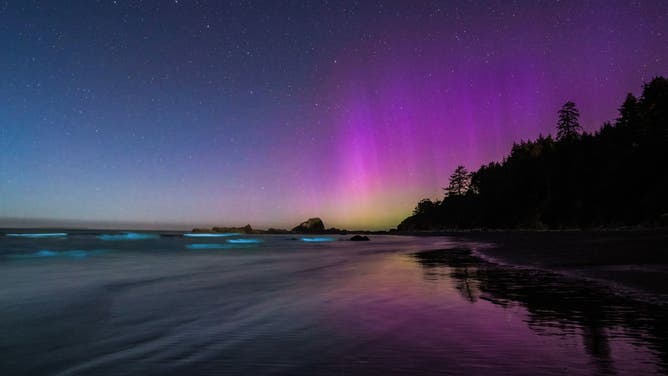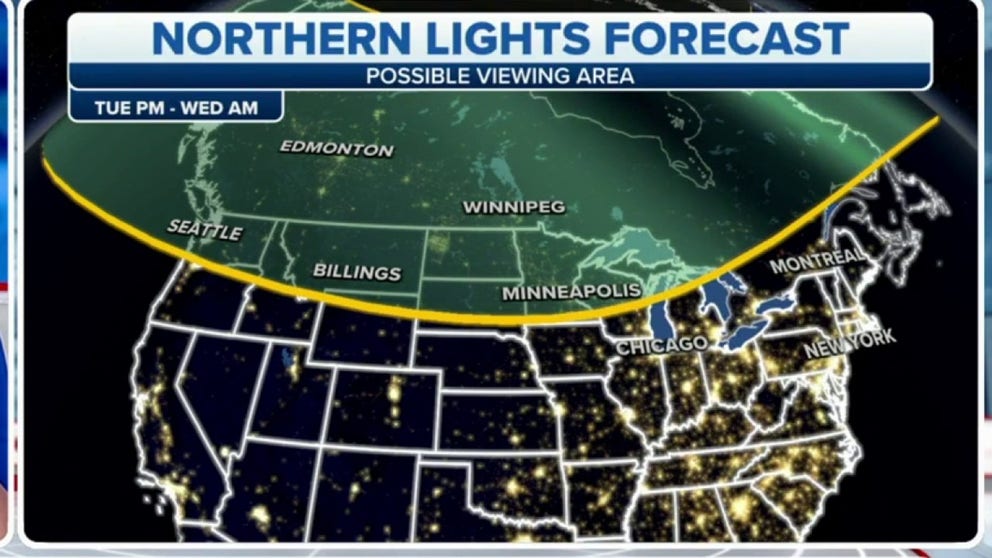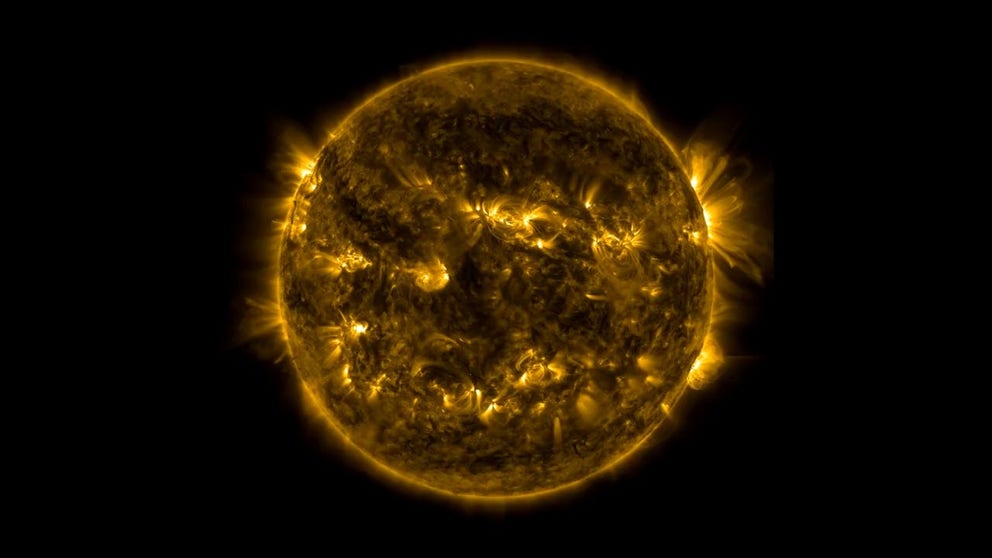Geomagnetic Storm Watch in effect as dazzling auroras could be on display from Seattle to Boston
Auroras lights could be visible low on the horizon for the U.S. Northern Tier, including in Seattle, Great Falls, Des Moines, Minneapolis, Chicago and Boston.
Geomagnetic Storm Watch issued for Tuesday
NOAA's Space Weather Prediction Center issued a Geomagnetic Storm Watch for Tuesday after a satellite captured a CME ejecting from the Sun.
The Sun's active cycle continues as a geomagnetic storm may produce aurora lights overnight Monday into early Tuesday further away from the poles from Seattle to Boston.
NOAA's Space Weather Prediction Center (SWPC) in Boulder, Colorado, issued a G2 (Moderate) Geomagnetic Storm Watch on a 5-level scale for Tuesday.
The SWPC said a coronal mass ejection, or CME, was observed on Sept. 14, and the Earth-directed component from the CME is likely to arrive early on Tuesday. According to NASA's Solar Dynamics Observatory, the Sun produced 9 M-class flares, 22 coronal mass ejections and one geomagnetic storm this past week.
Space Scientist Robert Steenburgh, with NOAA's Space Weather Forecast Office, said as the Sun approaches solar maximum, the SWPC has been busy.
"This is pretty consistent with what you'd expect as we run up into the solar maximum," Steenburgh said. "We're heading towards the maximum in our 11-year solar cycle. And this is well within what we consider a normal activity for that kind of thing."
NASA video shows solar activity over a week
Video from NASA's Solar Dynamics Observatory shows activity during a week ending on Sept. 17. NASA said space weather included 9 M-Class flares, 22 CMEs and 1 geomagnetic storm.
For most people, a Geomagnetic Storm Watch is not something to be concerned about. The watches help government agencies, power providers, telecommunication companies and satellite operators prepare to protect systems impacted by space weather.
"The key thing is it's not anything to be alarmed about," Steenburgh said. "It's something the sun's been doing for a long time, and it just gives us an opportunity to see some really neat stuff."
One group who might be concerned is pigeon handlers, according to Steenburgh. Ahead of low levels of geomagnetic activity, pigeon racers might delay releasing their birds because the birds would get lost.
"Pigeons use the magnetic field, Earth's magnetic field, as one of their many navigational tools. And so when it's disturbed, it throws things off; that's not the only thing they use to navigate, but it is one of the things they use," Steenburgh said. "You'll have conflicting information if you're a pigeon when certain tools are telling you one thing and your magnetic fields telling you another."
Where to view aurora lights this week
Geomagnetic storms can produce stronger aurora borealis lights or Northern Lights, which normally occur at the poles, but space weather can cause the lights to expand into the northern edge of the U.S.

(FOX Weather)
THE DAY THE NORTHERN LIGHTS COVERED THE PLANET: HISTORY OF EARTH'S GREATEST SOLAR STORMS
The exact timing of when the effects of the CME will arrive is still to be determined as space weather forecasters are tracking multiple solar eruptions at any given time. During the high solar activity in the solar cycle, more eruptions can make things interesting.
"One can catch up with another one or even overtake it," Steenburg said of back-to-back eruptions.
For now, the effects from this geomagnetic storm, including aurora lights, will happen late Monday night and into Tuesday morning.
"So there's some there's some uncertainty in terms of when this particular one originated from the Sun. If it wasn't the earlier one, then there a subsequent one that we're expecting," Steenburgh said. "Trying to piece all that together. It's always a challenge."
The aurora forecast from the University of Alaska Fairbanks Geophysical Institute predicts highly active auroral displays overhead in Alaska and Canada. Auroras will likely be visible low on the horizon for the U.S. Northern Tier, including in Seattle, Great Falls, Des Moines, Minneapolis, Chicago and Boston.
Those with cloud-free skies will also have a better chance to see the dancing lights. The best time to view the aurora is between 10 p.m. and 2 a.m., according to the SWPC.
Based on the FOX Forecast Center cloud cover forecast, Cut Bank, Montana, Marquette, Wisconsin, and Bismarck, North Dakota, will have mostly cloud-free skies for viewing the aurora.
Another thing that helps to see the aurora lights is a recent new Moon. With the mid-September new Moon, there is a better chance to see the aurora lights. Moonlight and city lights can wash out the Northern Lights when they might be visible in the northern U.S.

Purple aurora shine bright above bioluminescent seas along the north Washington coast on July 18, 2022.
(Mathew Nichols Photography)
If weather conditions don't prove favorable to see the lights on Tuesday, there will be more opportunities in the coming months. The Sun is in the midst of an active period in its solar cycle, which lasts 11 years.

